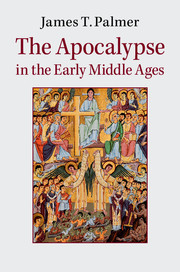Book contents
- Frontmatter
- Dedication
- Contents
- List of figures
- List of maps
- Acknowledgements
- List of abbreviations
- Maps
- Introduction
- 1 The end of civilisation (c. 380–c. 575)
- 2 The new urgency (c. 550–c. 604)
- 3 The ends of time and space (c. 600–c. 735)
- 4 Pseudo-Methodius and the problem of evil (c. 680–c. 800)
- 5 Charlemagne, pater Europae (c. 750–c. 820)
- 6 A Golden Age in danger (c. 820–c. 911)
- 7 The Year 1000 and other apocalypticisms (c. 911–c. 1033)
- Conclusion
- Select bibliography
- Index of manuscript references
- General index
- References
1 - The end of civilisation (c. 380–c. 575)
Published online by Cambridge University Press: 05 November 2014
- Frontmatter
- Dedication
- Contents
- List of figures
- List of maps
- Acknowledgements
- List of abbreviations
- Maps
- Introduction
- 1 The end of civilisation (c. 380–c. 575)
- 2 The new urgency (c. 550–c. 604)
- 3 The ends of time and space (c. 600–c. 735)
- 4 Pseudo-Methodius and the problem of evil (c. 680–c. 800)
- 5 Charlemagne, pater Europae (c. 750–c. 820)
- 6 A Golden Age in danger (c. 820–c. 911)
- 7 The Year 1000 and other apocalypticisms (c. 911–c. 1033)
- Conclusion
- Select bibliography
- Index of manuscript references
- General index
- References
Summary
Few periods defined medieval apocalypticism more than the waning of the Roman Empire in the West. For that reason, we start here with the fourth century AD rather than with Christ himself. The empire provided both a symbolic secular counterpoint to the Christian community, and a political body which it was prophesied had to fall before the End Times could begin. Sometimes the fate of the world already seemed inexorably bound to the successes and failures of the Roman world, and had for a long time, which meant that the profound crises which beset the Western Empire in the fourth and fifth centuries seemed to be of global importance. The migration and invasions of ‘barbarian’ groups, notably from the famous Gothic crossing of the Danube in 376 onwards, contributed to a destabilisation of political order and a cluster of anxieties about what it meant to be Roman and Christian. The cultural dissonance was pronounced. And when Rome itself was sacked in 410 by Alaric’s Goths and in 455 by Genseric’s Vandals, the cultural shock was muddied only a little by Alaric’s and Genseric’s adherence to a heretical form of Christianity and their pro-Roman ambitions. In the wake of such high drama, great patristic writers such as Augustine of Hippo and Jerome of Stridon began to set down strategies for understanding apocalyptic thought which responded to the changing worlds around them, while others saw nothing less than announcements of the approaching End itself. These were, in the words of one observer, the prophesied ‘perilous times’ (tempora periculosa [2 Tim. 3.1]).
- Type
- Chapter
- Information
- The Apocalypse in the Early Middle Ages , pp. 25 - 54Publisher: Cambridge University PressPrint publication year: 2014



